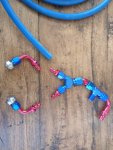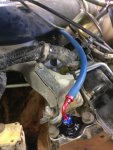- 3,285
- 1,209
- 113
- Location
- The actual midwest, NM.
Okay, I'm nearing the end of solving this particular problem on my (formerly) parts SEE.
Today it was confirmed that there are no air leaks left after the valve (thanks mostly to new copper washers from Bel-Metric at the banjo fittings) by having created a vacuum in the strainer.
After driving, and getting the out-of-fuel symptoms, I closed the valve. The strainer bowl stayed in place after loosening the screw. When I removed it, there was a slight sucking sound, then bubble sounds.
Like General Hood's, the tank was a mess. I never did more than rinse it out several times, getting maybe half a pound of crud out of it. The black coating (apparently a result of GP putting JP8 instead of diesel in there) was left in there.
I'm guessing that the additives I've been using has loosened this stuff up, so like General Hood, I'm getting generous amounts of what looks like coffee grounds in the strainer.
In my case it's easier said than done to drop the tank, so I'll have to drain it, "shovel" as much as possible of the crud over to the drain and rinse it out.
Then blowing some compressed air from the valve into the tank (which I've done before) should clear out the pickup tube - which appears to be my problem at this point.
Without getting the crud out of the tank first, the pickup will keep clogging up, so it's a short lived victory if you blow the line out and the engine runs fine afterwards. Been there, done that.
It's been covered in the "Owners thread", but I've had good luck with eliminating air leaks by using a Clamp-Tite tool on the plastic hose where age has made it a loose fit on the barbs.
By the way, it's not a complete coincidence that it turns out that the air leaks are gone now; yesterday I ordered more hose, washers, and new banjo fittings from Bel-Metric to go with the two new strainers I had bought.
Oh, well, I should've believed what the test hose told me last week; there were no bubbles, so the air leaks were apparently already taken care of. That includes the NAPA O-ring I'm using as a seal for the strainer. The vacuum in the strainer made the coin fall down, finally.
Today it was confirmed that there are no air leaks left after the valve (thanks mostly to new copper washers from Bel-Metric at the banjo fittings) by having created a vacuum in the strainer.
After driving, and getting the out-of-fuel symptoms, I closed the valve. The strainer bowl stayed in place after loosening the screw. When I removed it, there was a slight sucking sound, then bubble sounds.
Like General Hood's, the tank was a mess. I never did more than rinse it out several times, getting maybe half a pound of crud out of it. The black coating (apparently a result of GP putting JP8 instead of diesel in there) was left in there.
I'm guessing that the additives I've been using has loosened this stuff up, so like General Hood, I'm getting generous amounts of what looks like coffee grounds in the strainer.
In my case it's easier said than done to drop the tank, so I'll have to drain it, "shovel" as much as possible of the crud over to the drain and rinse it out.
Then blowing some compressed air from the valve into the tank (which I've done before) should clear out the pickup tube - which appears to be my problem at this point.
Without getting the crud out of the tank first, the pickup will keep clogging up, so it's a short lived victory if you blow the line out and the engine runs fine afterwards. Been there, done that.
It's been covered in the "Owners thread", but I've had good luck with eliminating air leaks by using a Clamp-Tite tool on the plastic hose where age has made it a loose fit on the barbs.
By the way, it's not a complete coincidence that it turns out that the air leaks are gone now; yesterday I ordered more hose, washers, and new banjo fittings from Bel-Metric to go with the two new strainers I had bought.
Oh, well, I should've believed what the test hose told me last week; there were no bubbles, so the air leaks were apparently already taken care of. That includes the NAPA O-ring I'm using as a seal for the strainer. The vacuum in the strainer made the coin fall down, finally.




![DSCN0393[1].jpg DSCN0393[1].jpg](https://www.steelsoldiers.com/data/attachments/465/465851-cf96226f6f2916e30b78160574499429.jpg)
![DSCN0394[1].jpg DSCN0394[1].jpg](https://www.steelsoldiers.com/data/attachments/465/465852-01b048794b2e75b2e0576d0c88294d98.jpg)
![DSCN0395[1].jpg DSCN0395[1].jpg](https://www.steelsoldiers.com/data/attachments/465/465853-95aa56130eaa6af34c5977be3afb8a69.jpg)


![DSCN0399[1].jpg DSCN0399[1].jpg](https://www.steelsoldiers.com/data/attachments/466/466162-086eb3e2c947d8890985b78b4eee93b8.jpg)
![DSCN0401[1].jpg DSCN0401[1].jpg](https://www.steelsoldiers.com/data/attachments/466/466163-8f1de268f0b65a0afa36787584449707.jpg)